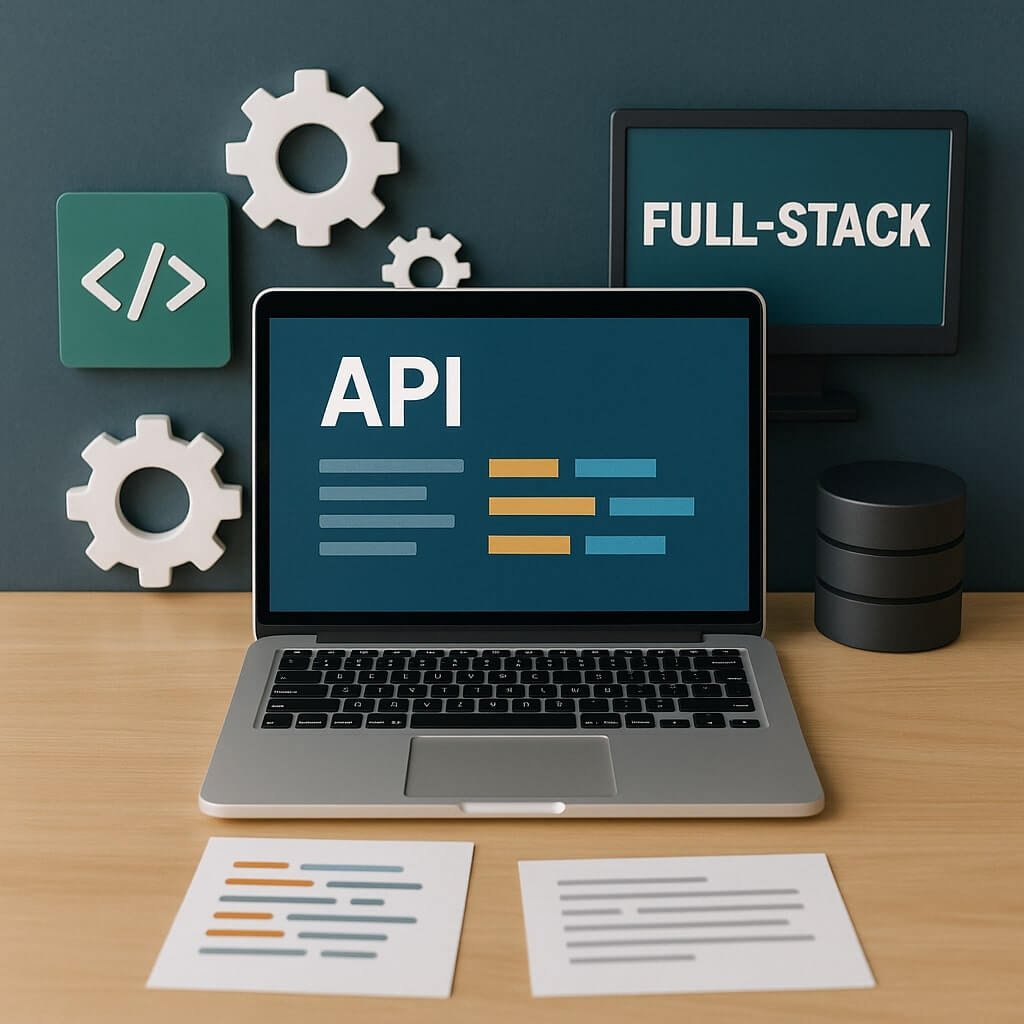Full-stack development refers to the comprehensive process of building both the front-end (client-side) and back-end (server-side) components of a web application. Modern full-stack developers are equipped with skills in HTML, CSS, JavaScript, databases, server technologies, and often DevOps practices.
As the complexity of applications has increased, so a need for seamless communication between these layers. This is where APIs (Application Programming Interfaces) come in — enabling consistent, efficient, and scalable communication between different software components.
What Are APIs and Why Do They Matter
APIs are defined sets of rules that allow one piece of software to interact with another. In the realm of full-stack web development, APIs serve as the connective tissue that enables the front-end and back-end to exchange data smoothly.
Key Functions of APIs:
- Data exchange between UI and server.
- Process encapsulation allows the reuse of logic across systems.
- Security enhancement by isolating services behind an interface.
Without APIs, building modular, scalable, and maintainable web applications would be practically impossible.
Types of APIs Used in Web Development
Understanding the different types of APIs is crucial for optimising full-stack workflows.
- Open APIs (Public APIs) – Freely available for external developers (e.g., Twitter API).
- Partner APIs – Shared under specific agreements with partners.
- Internal APIs – Used within an organization for internal applications.
- Composite APIs – Combine multiple APIs into a single call, ideal for microservice architectures.
These APIs provide developers with flexibility in how they structure data flows and service calls.
Front-End Meets Back-End: The Bridge via APIs
APIs bridge the gap between:
- Front-End Technologies: React, Angular, Vue
- Back-End Technologies: Node.js, Django, Laravel, Spring Boot
Workflow Example:
- A user clicks “Buy Now” on a web app (React).
- The click triggers a function that calls a REST API.
- The API interacts with the backend (Node.js + PostgreSQL).
- A response is sent back to the UI.
This seamless interaction wouldn’t be possible without the robust structure provided by APIs.
REST vs GraphQL: Choosing the Right API Style
REST (Representational State Transfer)
- Uses HTTP methods (GET, POST, PUT, DELETE)
- Based on resources and endpoints
- Easy to cache
GraphQL
- Queries return exactly the data needed
- Single endpoint
- Ideal for complex UIs
When to Use REST:
- Standard CRUD operations
- When caching is critical
When to Use GraphQL:
- Multiple nested resources
- Front-end driven development
Choosing between REST and GraphQL can shape the performance and flexibility of your full-stack applications.
API Authentication and Security Essentials
APIs are susceptible to attacks if not properly secured. Security should never be an afterthought.
Common Security Mechanisms:
- API Keys
- OAuth 2.0
- JWT (JSON Web Tokens)
- Rate Limiting
- HTTPS Encryption
Using authentication tokens and role-based access controls is critical in multi-user applications.
Real-Time Communication Using APIs
Real-time APIs enable instant feedback and live updates in applications.
Technologies Used:
- WebSockets
- Server-Sent Events (SSE)
- gRPC
Applications like chat apps, real-time dashboards, and live notifications heavily rely on real-time APIs.
APIs in Cloud-Native Development
Modern applications are built for the cloud. APIs are key in cloud-native architecture.
Integration Examples:
- AWS Lambda APIs
- Google Cloud Functions
- Azure API Management
Benefits:
- Scalability
- Microservices-ready
- Cost-effective deployment
Cloud APIs allow full-stack developers to build resilient, auto-scaling applications effortlessly.
API Gateways: Traffic Management for Devs
API gateways act as intermediaries between clients and services.
Functions:
- Routing requests
- Load balancing
- Rate limiting
- Logging and monitoring
Tools like Kong, AWS API Gateway, and Apigee streamline API governance and scalability.
Versioning and Lifecycle Management of APIs
APIs evolve. Managing changes without breaking client apps is essential.
Techniques:
- URI versioning (
/api/v1/) - Header versioning
- Media type versioning
Effective versioning ensures backwards compatibility and allows phased feature rollouts.
How APIs Foster Collaboration in Dev Teams
APIs make it easier for teams to work in parallel.
Example:
- The front-end team consumes mock APIs while the back-end development is in progress.
- DevOps configures CI/CD pipelines with API health checks.
This modularity boosts productivity and minimises dependencies.
APIs and Microservices: A Powerful Duo
Microservices depend on APIs for communication. Each service is an independent unit, exposing its own API.
Benefits:
- Flexibility in tech stack
- Independent deployment
- Scalable architecture
APIs are the glue that binds microservices together.
Best Practices for API Integration in Full-Stack Projects
API Integration Tips:
- Always use environment variables for API keys
- Implement retries for failed requests
- Validate input/output schemas (e.g., with Swagger/OpenAPI)
- Use pagination for large data sets
Following best practices ensures stability and performance across your stack.
Tools and Platforms to Enhance API Development
- Postman – For testing and documentation
- Swagger/OpenAPI – API design and validation
- RapidAPI – API marketplace
- Insomnia – REST client for debugging
These tools simplify the API lifecycle from development to deployment.
Future Trends in API-Centric Web Architecture
The API landscape is constantly evolving. Expect to see:
- Growth in API-first design
- Wider adoption of GraphQL Federation
- Increased use of AI-powered API management
- Rise of event-driven APIs
API-first development will soon become the new standard in full-stack workflows.
Frequently Asked Questions
1. What is the role of APIs in full-stack development?
APIs connect the front-end and back-end, allowing seamless data flow and logic execution across the stack.
2. Which is better for full-stack apps: REST or GraphQL?
It depends. REST is simpler and better for standard operations. GraphQL is ideal for complex data needs and flexibility.
3. Are APIs secure?
APIs can be highly secure if best practices like token-based authentication, HTTPS, and rate limiting are followed.
4. How do APIs improve team collaboration?
They allow teams to work independently by defining clear contracts between systems.
5. What tools should I use for API development?
Postman, Swagger, Insomnia, and API gateways like Kong or Apigee are excellent tools.
6. Can I use multiple APIs in one project?
Absolutely. Most modern apps integrate several internal and external APIs to deliver a complete solution.
Conclusion
APIs are the heartbeat of full-stack web development. They not only connect the front-end and back-end but also empower developers to build scalable, secure, and modular applications. Whether you’re integrating third-party services, creating microservices, or building cloud-native apps, APIs are essential.
As the web continues to evolve, embracing an API-first mindset will set the foundation for innovation and efficiency in every full-stack project.





